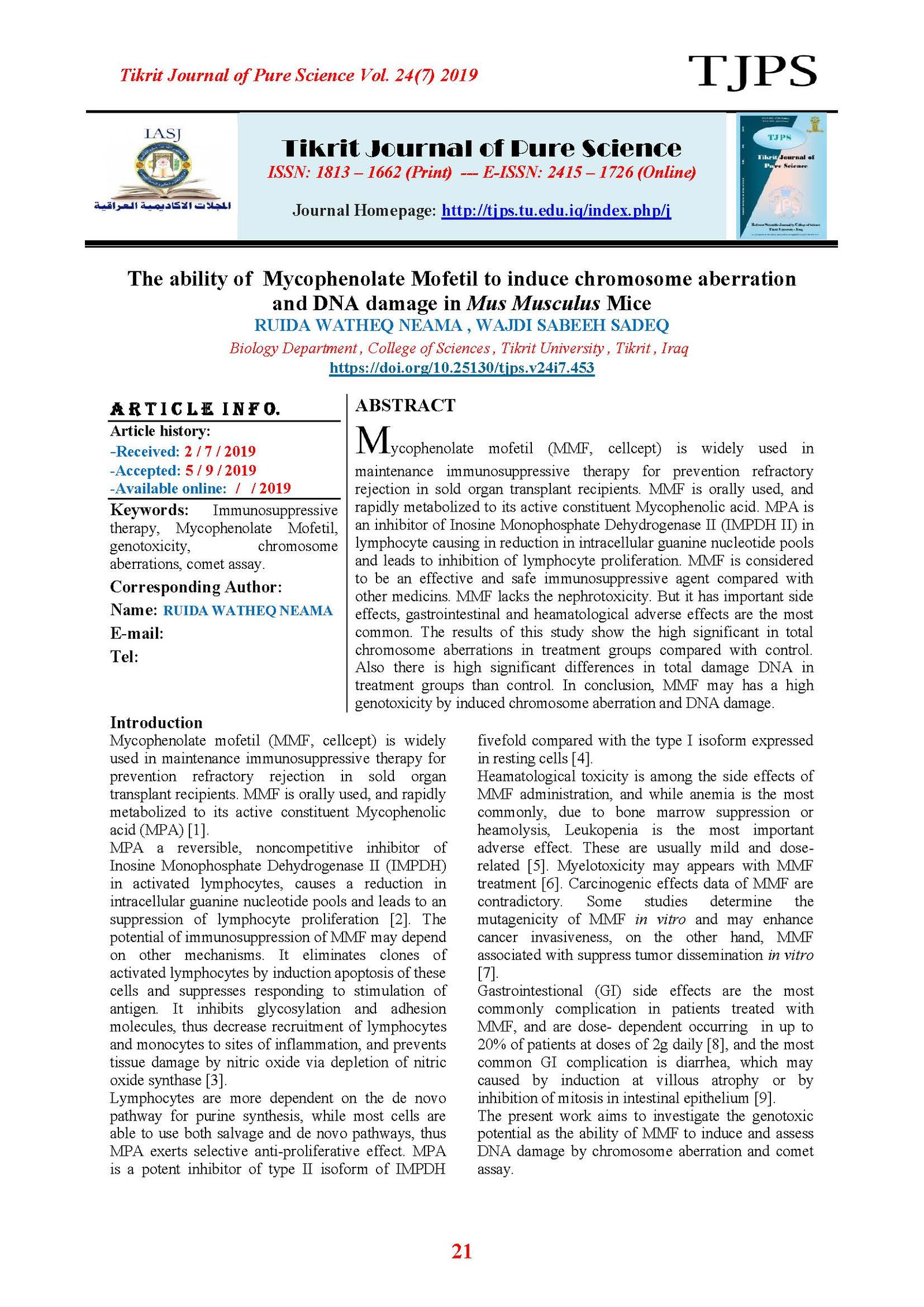The ability of Mycophenolate Mofetil to induce chromosome aberration and DNA damage in Mus Musculus Mice
Main Article Content
Abstract
Mycophenolate mofetil (MMF, cellcept) is widely used in maintenance immunosuppressive therapy for prevention refractory rejection in sold organ transplant recipients. MMF is orally used, and rapidly metabolized to its active constituent Mycophenolic acid. MPA is an inhibitor of Inosine Monophosphate Dehydrogenase ΙΙ (IMPDH ΙΙ) in lymphocyte causing in reduction in intracellular guanine nucleotide pools and leads to inhibition of lymphocyte proliferation. MMF is considered to be an effective and safe immunosuppressive agent compared with other medicins. MMF lacks the nephrotoxicity. But it has important side effects, gastrointestinal and heamatological adverse effects are the most common. The results of this study show the high significant in total chromosome aberrations in treatment groups compared with control. Also there is high significant differences in total damage DNA in treatment groups than control. In conclusion, MMF may has a high genotoxicity by induced chromosome aberration and DNA damage.
Article Details

This work is licensed under a Creative Commons Attribution 4.0 International License.
Tikrit Journal of Pure Science is licensed under the Creative Commons Attribution 4.0 International License, which allows users to copy, create extracts, abstracts, and new works from the article, alter and revise the article, and make commercial use of the article (including reuse and/or resale of the article by commercial entities), provided the user gives appropriate credit (with a link to the formal publication through the relevant DOI), provides a link to the license, indicates if changes were made, and the licensor is not represented as endorsing the use made of the work. The authors hold the copyright for their published work on the Tikrit J. Pure Sci. website, while Tikrit J. Pure Sci. is responsible for appreciate citation of their work, which is released under CC-BY-4.0, enabling the unrestricted use, distribution, and reproduction of an article in any medium, provided that the original work is properly cited.
References
[1] Picard, N.; Ratanasavanh, D.; Prѐmauel, A.; Le Meur, Y. and Marquet, P. (2005). Identification of the UDP-Glucuronsyltransferase isoforms involved in mycophenolic acid phase ΙΙ metabolism. The American society for pharmacology and experimental therapeutics 33 (1) : 139-146.
[2] Martin, P.J.; Storer, B.E.; Rowley, S.D.; Flowers, M.E. D.; Lee, S.J.; et al. (2009). Evaluation of mycophenolatemofetil for initial treatment of chronic graft- versus- host disease. Boold 113 (21): 5074-5082.
[3] Calmet, F.H.; Yarur, A.J.; Pukazhendhi, G.; Ahmad, J.; Bhamidimarri, K.R..(2015). Endoscopic and histological features of mycophenolatemofetil colitis in patients after solid organ transplantation. Annals of gastroenterology 28: 1-8.
[4] Dooly, M.A.; Cosio, F.E.; Nachman, P.H.; Falkenhain, M.E.; Hogan, S.L.; Falk, R.J. and Hebert, L.A.(1999). Mycophenolatemofetiltherapy in lupus nephritis: clinical observations. J. of American society of nephrology 10: 833-839.
[5] Dridi, I.; Ben- cherif, W.; Aouam, K.; Hassine, M..; Boughattas, N.A. (2013). Circadian variation in hematological toxicity of the immunosuppressive agent " mycophenolate mofetil" in rats. J. of applied biomedicine 11(1214-0287): 71-78.
[6] Gummert, J.F.; Ikonen, T. and Morris, R.E. (1999). Newer immunosuppressive drugs: a review. J. Am. SocNephrol 10:1366-1380.
[7] Dantal; J., and Pohanka, E.(2007) Malignacies in renal transplantation: an unmet medical need. Nephtology Dialysis Transplantation 22 (suppl-1): i4-i10.
[8] Bunnapradist, S. and AmbÜhl,, P.M. (2008). Impact of gastrointestinal- related side effects on mycophenolatemofetil dosing and potential therapeutic. Clinical Transplantation 22: 815-821.
[9] Orvis, A.K.; Wesson, S.K.; Breza, T.S.; Church, A.A.; Mitchell, C.L. and Watkins, S.W. (2009). Mycophenolatemofetil in dermatology. J. American academy of dermatology 60 (2): 183-199.
10. Proudlock, R.(2016) Genetic toxicology testing . Academic press in an imprint of Esevier.
[11] Tice, R. R.; Agurell, E.; Anderson, D.; Burlinson, B.; Hartmann, A.; Kobayashi, H.; Miyamae, Y.; Rojas, E;. Ryu, J. C.; Sasaki, Y. F. (2000). Single cell gel/comet assay: guidelines for in vitro and in vivo genetic toxicology testing. Environ. Mol. Mutagen. 35: 206-221.
[12] OECD (2015) Guidance document on revisions to OECD, Genetic toxicology test guidelines. Genetic toxicology guidance document.
[13] Brendler-Schwaab, S.; Hartmann, A.; Pfuhler, S.; and Speit, G. (2005.) The in vivo comet assay: use and status in genotoxicity testing. Mutagenesis 20(4): 245-254.
[14] Collins A.R. (2004). The comet assay for DNA damage and repair, principles, applications, and limitation. . Molecular biotechnology 26: 249- 281.
[15] Olive, P. L. and Banath, J. (2006). The comet assay: a method to measure DNA damage in individual cells. Nature protocols 1 (1): 23- 29.
[16] Liao, W.; McNutt, M.A. and Zhu, W. (2009). The comet assay: a sensitive method for detecting DNA damage in individual cells. Methods 48: 46-53.
